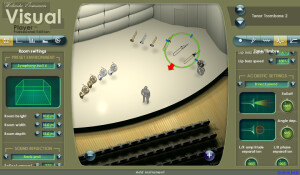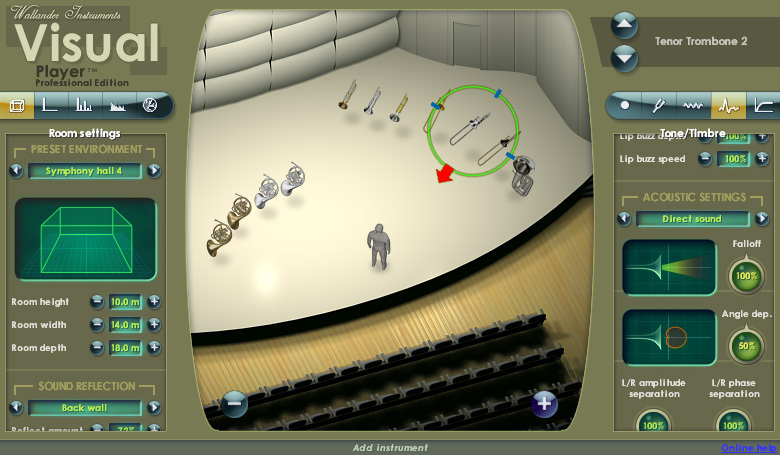While certain sound libraries have been waging a gigabyte war, others have taken the synthesis route, such as the Wallander WIVI, who with only its few hundred megabytes takes on the sample library titans.
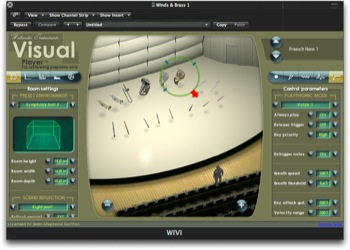 |
The power of modern computers has made it possible to virtually and realistically emulate complete orchestras, which seemed almost impossible a few years ago. Not so long ago, you needed a full rack of Akai or E-mu samplers or a battalion of networked Pcs and/or Macs to properly simulate orchestral scores, with libraries whose sound quality didn’t always merit the resources used.
Then came along gigantic libraries, such as the Vienna Symphonic Library or East West’s Symphonic Orchestra. Not only did you need powerful computers, but you needed huge storage space as well… However, you could set up a complete virtual orchestra with two or three 8-core Macs or the equivalent PCs.
So it’s quite surprising to discover new products that go against the current trend. Synful Orchestra, for example, that only takes up 140 MB of disk space or the Wallander WIVI, that’s being reviewed here, whose complete library is only 241.4 MB, and doesn’t include any samples. When you think about VSL’s hundreds of GB, you might tend to think it’s a joke. But if you listen to it, your smirk will disappear. So let’s review the Wallander WIVI Player, a virtual instrument dedicated to brass and woodwind.
The Idea
 |
Wallander has chosen to create a Universal Player that will load various instruments. Available for download, the WIVI Player is watermarked with the buyer’s information. The plug-in is available in VST and AU formats, Mac and PC. The standard brass and woodwind instruments are available on the editor’s site. Each instrument package contains three “variations”, with the exception of the Tubas (two versions), French Horns (four) and Clarinets (six, as there are both A and Bb models). Before going any further, the universal player and its extension concept need some explanation.
First of all, the WIVI is a synthesizer, not a sampler. Strictly speaking, it doesn’t use physical modelling, which means that it doesn’t emulate physical behavior or reproduce the physical structure of an instrument, but it does emulate its “ouput”, or final sound. Wallander says they’ve analyzed a huge amount of parameters in order to offer an instrument that doesn’t use standard signal processing or synthesis, but rather is based on acoustic principles and physical concepts. In concrete terms, you’ll find synthesis parameters that were specifically created for each instrument you load, but you will not be able, as with other modelling synths, to change the length of a pipe, its material, the shape of a mouthpiece or other “physical” characteristics. Every time you load an instrument, you load an ensemble of synthesis parameters and audio-spatial properties corresponding to the instrument, which can then be modified in the player itself.
Presentation
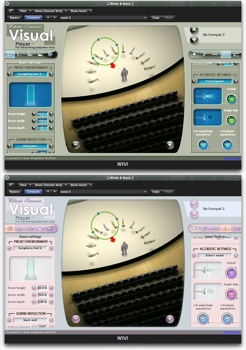 |
Why is it called “Visual Player”? Wallander has created an interface that allows the user to make simple settings as well as in-depth synthesis. The idea is to select an instrument as well as its location in a virtual environment. You can load (or unload) an instrument with the + or – buttons, then place it on the stage, move the audience, thus changing the sonic perspective of the sound emission as well as its reception, just by moving icons in the central interface. There’s also a color based view of the settings that gives you an immediate overview of the parameters and their position and state.
Moving icons is the easy way, but you can also make precision sound adjustments. On the left there are the settings dedicated to space handling (lots of parameters for the room type, direct sound, early reflections and reverb), and on the right are the settings of the instrument itself (tuning, vibrato, MIDI CC, etc.). And it gets even more complex than this. But at the same time it remains quite simple to make modifications, and that’s one of the main strengths of this instrument.
As for controllers: of course you can play WIVI just on a master keyboard and use the mod wheel for crescendo and other effects. But the software has been conceived with wind/breath controllers in mind, either the EWI or BC3 type. I bought the latter for this review (and for other purposes), and I can say it’s worth buying, because even if you aren’t a woodwind or brass player, the combination of keyboard playing and real time breath modulation gets some amazing results.
Spacialization
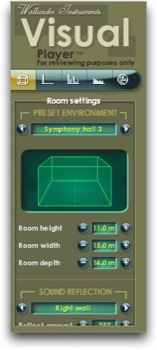 |
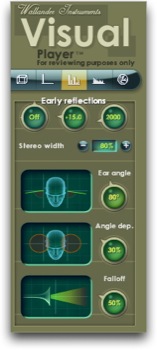 |
Arne Wallander, the editor, says he’d like his software to have some pedagogical potential. Of course, he notes that WIVI won’t rival pro pedagogic tools, however it may help you learn some basic knowledge of acoustics.
Therefore the plug-in’s left side offers an unusual variety of parameters. You have to consider the sound in WIVI as the result of three “sound layers”: direct sound, early reflections and reverberated sound, in relation to the space where the sound is produced. That is to say, that the chosen space will determine how each “sound layer” is perceived. Each layer works independently from each other, which allows you to use only one of them (Late Reverb for example) or completely isolate the sound from any resonant or reverb simulation, in order to use it with an external reverb.
The first tab displays Room Settings, which allows you to create your own room. First you choose the type of space: Hall, Studio, Church, External Reverb (completely dry sound), Wet and Dry Sample Library (which emulate the space used by sample libraries). You can define the three dimensions (length, height, width). Imagine a “room” which can have sides from 1 to 500m… Then you’ll define the reflections (wall by wall!), the microphone noise and choose between the three available stereo outputs.
You’ll find the following parameters in each of the other three tabs: output choice, Volume, Hi and Low Cut, Bass Boost and Cut and stereo width. There’s also Ear Angle and Angle Dep. that set the listening angle and Falloff which determine the sound attenuation/distance ratio (graphically monitored). Late Reverb also benefits from reverb settings, Time (from 0.1 to 20 seconds), PreDelay, Damping and Diffusion.
The last tab, Global Settings lets you choose GUI colors (by theme), the controller speed (most of the settings and access to pull-down menus are by click’n’drag), plug-in mode (stereo, mono and mono compatible) and sampling frequency (from 6 to 384 kHz).
Controls
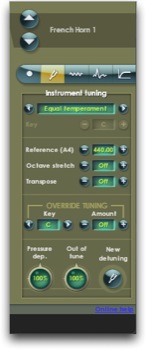 |
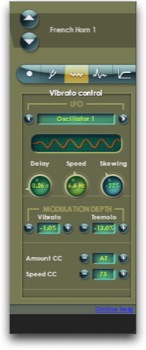 |
On the right side, there’s another five-tab system. The first one, General Settings, includes Volume, Pan (which then has priority over stage positioning), and several MIDI settings, including Breath Controller which commands the instrument’s volume/dynamic (which can be replaced by any other CC), as well as range and pitch bend. It should be noted that WIVI can be used with 14 bit resolution controllers (16384 steps instead of 128). In the second tab, you’ll find all settings related to plug-in tuning.
The third tab, Vibrato Control, lets you control two LFOs, the first being dedicated, by default, to the vibrato, the other to growl and other techniques. On the menu: delay, speed and transition (from the original sinus wave to a saw tooth), depth, controller choice (one for rate, the other for speed) and some random deviations which are useful for creating some irregularities in vibrato or tremolo, thus avoiding that they sound too artificial.
The fourth tab is Tone/Timbre. The first few settings are dedicated to Mutes, which vary according to the chosen instrument. So you have an Overblown mode for flutes, several types of mutes for the brass (cup, harmony, wah, bucket, etc.) but nothing for clarinets, oboes, etc., but of course, that’s normal. Then comes the Tone/Timbre, which isn’t really a filter but produces various modifications. Thus Amount (0 to 2500 %) defines the timbre volume without changing transients or breath sounds.
Then there’s a really interesting tool, the Formant Shift. It can create unreal instruments (a 10m contrabassoon or a 2cm trumpet), while keeping a “realistic” sound. With proper settings, it can also be used for emulating old or oriental instruments, such as duduk, ney, bombardon, serpent, etc.
You can also set level, pitch, depth and other parameters of various noises associated with the instrument and/or the instrumentalist (key, valve, breath, lips noises, etc.). Finally a bunch of settings let you refine spacialization parameters (Angle and Falloff for each of the three “layers” Direct, Early, Late), this time only modifying the current instrument, and not the plug-in’s global sound. The last tab, Control Parameters, has everything needed to define controllers (portamento, pith bend, breath, randomizer, etc.). Here, each controller setting can be refined, with range limitation, incoming MIDI compression, in a global way or note by note! There’s also a clever Polyphonic mode, in which you can open several instruments, give each a voice number that will correspond to the voicing of chords that you’re playing (low notes for a tuba, high for oboe, for example). This is an easy and practical way to try, or even double-check an arrangement or an orchestration, by simply playing chords on a keyboard.
Results
 |
 |
Once you’re used to commanding the volume with the BC3 controller (or with the mod wheel or other CC), and once you’ve accepted that no breath means no sound, the plug-in unveils all its power, efficiency, expressiveness and realism. Even if some instruments sound better than others, there are a lot of phrases or specific techniques you can do with ease and realism… especially in comparison with sample libraries. The continuous dynamic level plays a major role in this realism because, even if you only have a 128 controller values, no sample library could offer the same regularity.
You also get used to working without automation or MIDI Learn. As Arne Wallander says, this is due to the fact that “WIVI uses hardware-accelerated graphics for the interface, which means the WIVI interface gets priority over the host most times. This means that if you have knobs and sliders animated in the background, this may severely impact host/audio performance”. In order to compensate, there’s a lot of WIVI parameters that are factory mapped to MIDI CCs. With use, the “reverb” section quickly becomes essential: it’s more a component of the final sound than an effect. And even if the use of an external reverb can be useful in mixing WIVI with other instruments, you’ll probably end up using the internal settings as much as you can. The stereo precision and resonance in the designed rooms are impressive. Even if WIVI is, by default, designed with an orchestral context in mind, you can also use it in modern compositions, or even big band arrangements (muted or wah-brass work pretty well in this context).
Let’s hear some audio examples: here’s a contrabass clarinet. Or an oboe. A trumpet flutter, free from tempo constraints, unlike samples. Three muted trumpets, played in Polyphonic mode, volume with BC and Wah with aftertouch.
Here is a factory flute. Let’s raise noise parameters, then modify the formant settings to create new instruments : –78 with MIDI transposition one octave lower, then + 78 with MIDI transposition one octave higher, and without transposition. Finally, here’s a tuba, then modified. I also suggest visiting the editor’s site and listening to their demos.
Conclusion
Wallander WIVI clearly demonstrates that, beside the sample-based virtual orchestras (the astonishing Vienna and the eagerly-awaited Play version of the EWQLSO), there’s still room for other solutions. The new 8-core (and soon 12, 16, 32) computers offer new perspectives into the modelisation domain. The technical choice made by Wallander, to work with modelisation, but in rather uncommon ways, is original. And above all, the results speak for themselves.
WIVI has a lot of expressiveness, and this is its best point. No bugs or unusable sounds, there are only some barely audible noises or clicks when adjusting some parameters, but that’s not a problem, seeing that they’re not parameters you need to change in real time. It’s hard to believe that WIVI is Wallander’s first release, as it’s such a skillful achievement. And you’ll be surprised with its very low CPU consumption, which is further proof of Wallander’s know-how.
So, is there a difficult choice to make between samples and modelisation? First, it’s a matter of taste, but it also depends on the use you’ll make of your orchestra and how fast you want to play, program and tweak music material. Both solutions sound great, even if some solo instrument samples show a kind of thickness which seems to be lacking in WIVI. Though, once WIVI plays a full orchestration or arrangement, this is not a “problem” anymore. And in terms of speed, WIVI is unbeatable: no layers to load, no articulation programming, almost everything is done in real time. Another great advantage is its creative potential, in terms of sound design: you can create totally new instruments, whose sound will still remain relatively realistic, and place them into strange spaces that are nevertheless subjected to acoustic laws (only parallelepiped). WIVI has boldly entered the fray with its virtual brass and woodwind solutions… So, what’s coming next from Wallander?
[+] Concept
[+] Ergonomy
[+] Powerful & Inspiring
[+] Sound quality
[+] Expressiveness
[+] Realism
[+] Stability
[+] Instrument extensions
[+] Optimization
[+] Polyphonic mode
[-] Wind/Breath controller strongly recommended
[-] A few clicks or artifacts on some parameters
[-] You can’t enter values with the numeric pad
[-] No pull-down menus
[-] No .pdf manual


